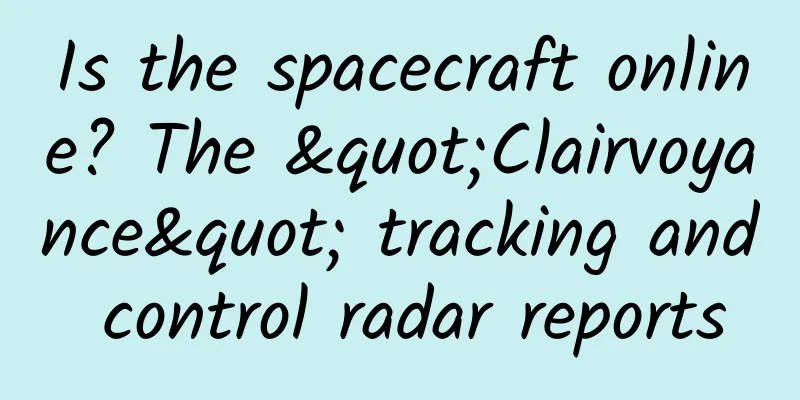Is the spacecraft online? The "Clairvoyance" tracking and control radar reports

|
"Jiuquan radar tracking is normal!" ============== "Weinan radar tracking is normal!" "Taiyuan radar tracking is normal!" "Qingdao radar tracking is normal!" … Whenever there is a flight mission, we can always clearly hear similar reports coming from the command and control center hall from the live TV broadcast. These radar devices that "monitor" the spacecraft's flight are like the "kite string" that firmly grasps its flight trajectory. They have the ability of "clairvoyance" and can "see" every move of the spacecraft no matter how high or far it flies. Standing high and looking far, the "Fiery Eyes" are only used to track the rocket to the end . When performing the launch mission, in order to accurately track the position of the rocket, in addition to relying on the optical equipment on the rocket, it also relies on the radar working with radio waves to measure the trajectory of the rocket's active phase. Compared with optical tracking that is limited by weather and telemetry that relies on equipment on the rocket, radar monitoring is safer and more reliable for detecting the rocket's ascent phase. In this year's space station construction mission, the country's first large-aperture radar telemetry integrated system was put into use. This radar is mainly responsible for the outer orbit measurement task of the rocket's active segment. It has a detection distance of thousands of kilometers and can complete the downlink reception and demodulation of the rocket's telemetry signal, thereby achieving precise tracking of the rocket, which is of great significance to the rocket's safe flight. These "clairvoyance" comes in different forms. For example, the "reflection tracking" radar works by "asking and answering itself" : the radar emits a radio signal, which is reflected back to the ground after encountering the spacecraft, helping the flight control center understand the flight trajectory of the spacecraft. This process is like the radar "asking" itself and finding the answer itself. The "transponder tracking" radar works by "one question and one answer": the radar sends a signal, and the transponder on the spacecraft receives it and then returns a signal to the ground radar control station. This process is like the radar asking: "Where are you?" The spacecraft replies: "I'm here!" How high do these "eyes" work? The detection range of "reflection tracking" radar is several hundred kilometers, and the detection range of "response tracking" radar can reach thousands of kilometers. Our spacecraft enters orbit at an altitude of hundreds of kilometers above the earth, so the radar can easily "see" it. The radar has a clear view and is designed to provide comprehensive protection for hundreds of artificial satellites from various countries in space, as well as spacecraft such as near-Earth space stations. How can the radar "see clearly" which one is our Shenzhou spacecraft and which one is our own space station? On each spacecraft, unique receivers, transponders and other equipment are installed as "assistants" for the radar. This process is like making a phone call. The radar sends a signal through radio waves, sending a signal of "where are you" to the spacecraft. The receiver installed on the spacecraft receives this signal and sends position feedback in the form of radio waves through the transponder. With the help of these guidance information, the radar can accurately intercept the target, start tracking, and measure more accurate trajectory information of the spacecraft. In addition, in order to provide high-precision measurement performance, researchers have upgraded the new generation of measurement radars with the ability to image the target, and use position and image information to ensure that the radar will not "make a mistake." In this year's launch mission, researchers also developed a new generation of ship-borne measurement radar . This inevitably raises the question: Why do we need a ship to carry out space missions? The reason is that the survey ship is an important part of the aerospace measurement and control network . Compared with land-based measurement stations, the survey ship can flexibly select points and deploy stations in the vast ocean, and conduct mobile emergency measurement and control. It can not only measure the orbit of the aircraft, but also send control instructions to remotely control the satellite to change orbit, adjust attitude, and deploy solar panels. The new generation of shipborne measurement radar adopts a high-reliability design. The radar is equipped with advanced attitude measurement equipment. It is not afraid of sea waves. It can obtain the same high measurement accuracy as the ground when the survey ship sways, providing high-precision orbit measurement data for aerospace measurement and control missions. |
<<: Why does my voice sound so bad in the voice chat? Here’s the reason!
>>: After COVID-19, I "felt stupider". Do you also have "brain fog"? How to relieve it? See here!
Recommend
Microsoft Office iOS / iPadOS version upgraded to a new design: a lot of rounded UI, light background buttons
[[440046]] On December 13, according to feedback ...
Sogou advertising efficient delivery case study!
01. Insights into the thermal insulation material...
Tian Yuan - Teach you how to make a course training camp, learn it in 1 day, teach you how to pay for knowledge and make courses
Tian Yuan - Training camp to teach you how to make...
Curious questions for the Year of the Snake! Explore the most "snake"
Review expert: Wang Lei, National Park and Nature...
How to write a bidding promotion plan?
Bidding promotion is a keyword advertising promot...
Whose rhino also has "lip augmentation"? Let's meet this "rhino" with thick lips!
Rhinoceros have been found on the vast land of my...
An inventory of the characteristics of major information flow channels such as Baidu and Tencent, save it now!
With the development of social media , Weibo, Ten...
How to start a lead generation training camp from scratch?
I recently spent a month polishing a traffic gene...
Didi, Bilibili, Xiaohongshu... Reviewing the growth path of 10 phenomenal products
Product Life Cycle Before reviewing the product, ...
Detailed explanation of brand upgrade case: What is the real function of LOGO?
Some time ago, a restaurant found me and said tha...
The classic TV version of "Tank War 2014" is reproduced on the big screen
. Screen: Sound Effects: operate: Plot: Experienc...
Baldness treatment upgraded: With the help of gene editing, hairless mice grow human hair!
Written by: Hao Jing Editor: Kou Jianchao Layout:...
A guide to advertising in the beauty industry
Today, let’s share the “Juliang Qianchuan Beauty ...
Home appliance giants are focusing on smart home: seizing a market worth hundreds of billions
Apple (647.35, 2.53, 0.39%), a giant in today'...









